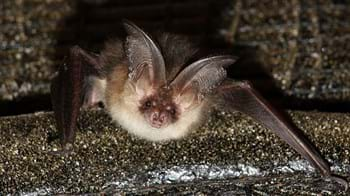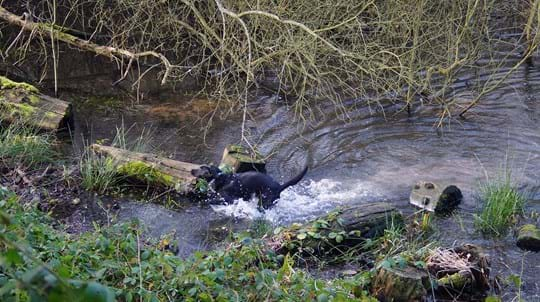
Ashenbank Wood
Cobham

Woodland Trust wood group
- Ashenbank Wood
- Ashenbank Wood Extension
29.95 ha (74.01 acres)
TQ675692
Explorer 163
OS Landranger 177
Ashenbank Wood has all bases covered with its spectacular show of bluebells in spring, ancient features to discover and fantastic views all year round.
It’s a Site of Special Scientific Interest in the Kent Downs Area of Outstanding Natural Beauty and is teeming with extraordinary wildlife. Stand in the shadows of gnarled, veteran trees and you’ll be among shy dormice, rare bats and woodland wildflowers.
Features
- Parking at site
- Public access
- Spring flowers
- Waymarked walk
- Broadleaved woodland
How to get to Ashenbank Wood
Ashenbank Wood is a 30-hectare (74-acre) site, 0.8km (0.5 miles) north of the village of Cobham and 6.4km (4 miles) west from the centre of Rochester.
It is bordered by several parks and woods, all of which are linked by The Darnley Trail, a 10km (6.2-mile) circular route.
From the London-bound A2, take the exit marked ‘Cobham, Shorne’. At the roundabout, take the second exit signed ‘Cobham’. The site is located approximately 200 metres down Halfpence Lane - the entrance to the car park is located on the right-hand side of the road.
The nearest train station is Sole Street, 3.8km (2 miles) from the Woodland Trust car park.
Visit National Rail for more information.
The nearest bus stop is at the war memorial in the village of Cobham, close to the junction of The Street and Halfpence Lane.
Visit Traveline for more information.
Facilities and access
Access is available across most of the site, except for part of the southern end which is still privately owned.
There are six entrances to Ashenbank Wood which lead onto the permissive path network.
The main entrance is accessed from the Woodland Trust car park. This has two exits into the wood via kissing gates, with the one beside the wooden 3.6-metre gate being an all-access kissing gate suitable for pushchairs. The waymarked trails start from here.
Three entrances are along a public footpath at the south-west and in the north-east corner via all-access kissing gates.
A further two entrances are situated off Scotland Lane at the extreme north-west corner and the west side of the wood, both via pedestrian-only access kissing gates.
Small sections of the paths have a stone or tarmac surface, but the majority of paths are grass and earth which can get slippery and muddy when wet. There are some steep slopes in the western side of Ashenbank Wood where some paths have dug-in steps.
There is one waymarked circular trail in the wood, which takes you on a tour of the site. Some sections of this trail crosses over fallen trees into which the path has been built, so is unsuitable for wheelchairs or pushchairs.
There is free parking on site, with space for up to 10 cars, just off Halfpence Lane. There is a barrier across the car park entrance which is closed every evening at dusk or 8.30pm during the summer, and is opened by 9am every morning.
The nearest toilets are at Shorne Wood Country Park visitor centre around 0.4km (0.3 miles) from Ashenbank.
Wildlife and habitats
Animals
Ashenbank Wood is home to several rare and interesting species, from the declining hazel dormouse to the elusive brown long-eared bat. The wood is highly regarded for its obligate saproxylic beetle (beetles that only exist in deadwood) assemblage, including the rare click beetle and the tanner beetle.
Trees, plants and fungi
Ashenbank Wood has a rich flora. Many of the plants here are ancient woodland indicator species, and 135 of the trees on site are ancient or veteran. The oldest tree in the wood is an incredible 350 years old, and some have girths of up to six metres. There is also much dead and decaying wood at Ashenbank, supporting a variety of specialist invertebrates and fungi species.
Habitats
Ashenbank Wood is a mix of Ancient Semi-Natural Woodland (ASNW) covering around 40% of the site, with wood pasture and parkland over 60% of the site.
This site was designated as a Site of Special Scientific Interest (SSSI) in 1968.
We bought the wood in 1984. Some parts of the site were compulsorily purchased in 2000 by a rail company but acquired back in 2006.
About Ashenbank Wood
Archaeological features
Look out for the Bronze Age barrow (Scheduled Ancient Monument) dating from 2400-1500 BC, which you’ll find on the high ground in the centre of the wood. And passing through the middle of the wood you can see the remains of a shallow medieval (or potentially older) wood bank.
There are also the remains of four Second World War bunkers built by the RAF to accommodate personnel from Gravesend airfield. Most of the structures were removed in the early 1950s.
Research by the Oxford Archaeological Unit in 1995 concluded that, prior to the early 19th century, most of the northern part of Ashenbank Wood was a mix of ancient fields, rough grazing, heath and wood pasture with local areas of trees and scrub.

Credit: Sally Mclaren/WTML
Cobham Hall Estate
Ashenbank Wood once belonged to Cobham Hall Estate, and areas of the site were managed as traditional wood pasture.
Grazing is likely to have ended in the 20th century and many of the original open areas are now covered by woodland, but a woodland restoration project has seen the reintroduction of woodland grazing, reinstating the mixed habitats.
Look out for the ancient trees indicative of woodland pasture as well as the ancient and veteran sweet chestnuts planted as part of Humphry Repton’s landscape design for Cobham Hall.

A lasting legacy
This wood is just one of many to have been protected by gifts in wills, securing it for generations to come. Your legacy gift could also make a real difference to woods, trees and wildlife.
Learn what your gift could meanThings to do at Ashenbank Wood
Walking
Explore the wood via our waymarked trail, which takes you in a circular tour of the site.


































